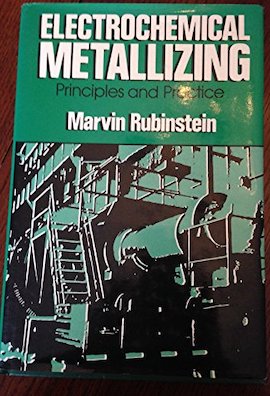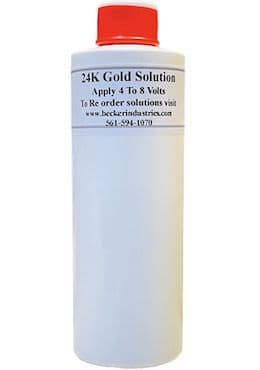
-----
Voltages for Brush Electroplating
Q. My name is Don and I'm new to 'Brush Electroplating'. I have yet to plate my first piece. This is only a hobby, but I do have some technical questions.
These questions pertain to small parts from 10 mm up to 100 mm
1. Which gives the best results: brush or anode with with cotton?
2. I understand the size of the piece determines the amount of voltage. For small parts made of copper, nickel or silver, what is the best operating voltage and amperage rating for gold plating? (coating will be medium to heavy)
3. Which power supply will give the best results for gold plating small parts only: Give voltage & amperage rating.
- Milledgeville, Georgia, USA
2000
A. Donald,
First welcome to the world of brush plating. The answers to your questions are as follows:
1. I am confused as to what you mean by brush, we use anodes of various sizes wrapped with cotton or some type of sleeve
(Pellon, Dacron, Wool, etc.). The wrapping serves two purposes: first, it holds the solution while plating; and second, it acts as a barrier between the anode and the work piece.
2. The voltage for Gold plating should be kept low between 3-6 volts, if the Gold deposit starts to look dark simply turn down the voltage. The amperage rating will range from 1-3 amps depending on the size of the area you are plating and your voltage setting. On very small parts you may not even notice the amp meter moving.
3. With just plating small components you can use a small machine at 15 volts and 15 amps. You must also take into account the voltage and amperage required for the activators and any preplates that are needed; on small parts this size machine will work.
- Valencia, California, USA
2000
![]() Thank you for the prompt and precise reply. It is greatly appreciated. As to your question about brush plating, some companies supply an electroplating kit that contains an actual brush with bristles. The handle is metal with horse-hair type bristles that is connected to the positive terminal of the power supply. They just used a brush instead of an anode covered with a dacron sleeve. Would assume the dacron sleeve would give better results. Anyway,thanks again for answering my questions.
Thank you for the prompt and precise reply. It is greatly appreciated. As to your question about brush plating, some companies supply an electroplating kit that contains an actual brush with bristles. The handle is metal with horse-hair type bristles that is connected to the positive terminal of the power supply. They just used a brush instead of an anode covered with a dacron sleeve. Would assume the dacron sleeve would give better results. Anyway,thanks again for answering my questions.
Don Roberts
- Milledgeville, Georgia, USA
2000
Electrochemical Metallizing by Marv Rubinstein

on eBay or Amazon
or AbeBooks
(affil link)
A. Don,
I work in an electroplating shop. We used to do gold and silver plating, but have been out of the business for awhile. I electroplate cadmium in a large bath, but I also do stylus cad.
I agree with David Crocker, I have never heard of horse hair bristle brushes. First of all you must come in close enough of contact with a part to create uniform, even plating. The only way I know of that works well with any plating is the anode covered with a cotton insulator.
You can use platinum, stainless steel, and carbon rods as your "brush" I would recommend a variable 15 volt rectifier rated at 20 amps max output. You will adjust the voltage for plating. The current (amps) will follow with the correct amps. In other words, you will plate by voltage, not amps. Your surface area, in square feet, will determine your amps.
As David said, your appearance of the plating will determine your voltage. If it has dull luster, increase the voltage. If you have the voltage too high, you will develop nodules of the metal you are plating within your cotton insulator, and the plating will be pitted or burnt. Arcing will occur eventually.
Hope I have given you some helpful advice.
- Seattle, Washington, USA
2002
A. Fine horse hair brush is used to apply gold foil on objects. Richard
Richard MorrisRetired - Las Cruces, New Mexico, USA
November 2, 2015
![]() Hi Richard. You're right of course! Perhaps the people offering brush electroplating kits with horsehair brushes got a bit confused about what they were trying to offer :-)
Hi Richard. You're right of course! Perhaps the people offering brush electroplating kits with horsehair brushes got a bit confused about what they were trying to offer :-)
Regards,

Ted Mooney, P.E.
Striving to live Aloha
finishing.com - Pine Beach, New Jersey
Ted is available for instant help
or longer-term assistance.
Q. I have one last question concerning the power supply. The two responses received so far advise using a power supply rated at 15 to
20 amps. I've seen one advertiser that says it's possible to use batteries to brush plate. That would put the amperage used in the milliamp range. Is it advisable to use a 15 or 20 amp power supply for small work or can you use a small variable AC adapter, say 3 to 15 volts DC at 500 ma? I don't understand why the high amperage rating is needed. If it is, I want to use the correct power supply for the job.
Thanks guys!
- Milledgeville, Georgia
2003
A. Hi Don. It is possible to do electroplating with small batteries; our FAQ on How Electroplating Works instructs schoolchildren to use one penlight battery for their science projects in electroplating. But the heart of the issue is Faraday's Law of Electrolysis, which says: How much metal you move from the anode to the cathode is exactly proportional to how many electrons you move from the anode to the cathode, i.e., the current you apply multiplied by the time you apply it for. That's just how electroplating works, and there's little you can do about it.
So, if you have a couple of small batteries, you can only plate slowly (because of their limited current), and you can only plate a very thin layer on a very small part before the batteries are exhausted. If you are plating pin-head size parts, milliamps will be sufficient; if you are plating parts of a few square inches, 3 amps or more will be required.
As you know, electroplating requires DC current, because it is the movement of electrons from anode to cathode through the power supply and its wiring that drives the electroplating -- by oxidizing (removing electrons from) the metal of the anode thus causing it to dissolve as positively charged ions into solution, and supplying electrons at the cathode, which reduces those positively charged ions back to metal.
The least expensive power supplies just convert AC current to hump-backed waves of DC current with the voltage oscillating from zero to maximum (high ripple), while more expensive power supplies filter the DC current to a smoother more consistent DC voltage (low ripple) for faster plating and less chance of unwanted side effects from the variable voltage.
Like in other areas of life, there is no limit to how much you can spend; the question is what can you get away with, and at what point is corner-cutting anti-productive. For a hobby-only application, 500 ma is probably okay. Good luck.
Regards,

Ted Mooney, P.E.
Striving to live Aloha
finishing.com - Pine Beach, New Jersey
Ted is available for instant help
or longer-term assistance.
Q. I have been looking at power supplies for gold plating. The price range is very big going from around £40 to more than £200. But my question is can you use a model train regulator?
Going from AC to DC, a friend says these can give a current from 0 up to 9 V. Would these work, and if not why? As you may guess I don't know much about this type of thing. My other statement is if you can do gold plating with a small £40 machine why would you need to buy a expensive one -- is it simply it looks more professional if you have a nice big box?
- campbeltown scotland
November 24, 2014
A. Hi Paul. Your friend is probably confusing you: current and voltage are not the same thing :-)
Voltage is like water pressure. If you live on the fortieth floor of an apartment building, four hundred feet in the air, the water pump supplying you must have offer enough pressure to overcome that 400 foot of water head to keep pushing the water up. Current, measured in Amps, is like the flow rate of water. A fireman's hose delivers far more water in a minute than your garden hose can.
Your power supply requires enough voltage to make the plating occur, and enough current that you can plate the surface of your parts at a practical speed and a speed at which satisfactory plating will occur. Larger, more expensive power supplies may offer higher voltage for specific needs, and/or higher current for faster plating or handling larger parts, and/or lower ripple for more reliable plating, and/or automation features like slowly ramping the voltage up. If the plating you intend to do is small and easy, there's a good chance you can do it with inexpensive hardware.
As we've said on other threads, you can teach a school child to play a piano in 5 minutes or to electroplate in 5 minutes. But being able to plink out Twinkle Twinkle Little Star doesn't mean they can enthrall an audience with their rendition of Rhapsody in Blue. Gold plating of jewelry and nickel plated car emblems is very easy, whereas trying to copper-nickel-chrome plate an old diecasting is a major challenge to platers with decades of experience. If you only want to gold plate very easy things, you probably don't need exotic equipment.
Luck & Regards,

Ted Mooney, P.E.
Striving to live Aloha
finishing.com - Pine Beach, New Jersey
Ted is available for instant help
or longer-term assistance.
November 2014
Thanks for your reply. I like your music references but keeping in mind I know nothing about this subject I still don't know if a model train regulator would work? I live in a part of Scotland that is remote and not many jobs (so I have very little cash), so I was looking at trying gold plating to make some cash. I don't intend to do large jobs just things like you mentioned car badges, etc. Sorry if I am being stupid on this subject or missing the point, but to give it a go I need to try it on a very small budget -- hence the question about the model train regulator as they are very cheap compared to the gold plating machines.
Paul wilkinson- campbeltown scotland
November 24, 2014
Hi again, Paul. Sorry, the point was if it's a hobby and a learning experience, a model train transformer is fine. You should be able to do certain very easy jobs with it, while learning from your failures.
But if you are planning to sell a plated product or electroplating service, and you're not willing and able to use professional equipment, and to secure knowledge in a field that you admit that you know nothing about, I think you'd better re-think that plan. Plating is a chemical and electrochemical art and science; and you need to acquire some expertise in the chemistry, electrochemistry, practical requirements, before you sell the product of that expertise. If you don't have enough curiosity to investigate the issues we're talking about of voltage, current, waveform, ripple, so that you understand the effects of the corner-cutting of trying to use a model-train transformer, that's fine as long as it stays a hobby -- hobbies are supposed to be fun, not a burden, and they only need to involve things you enjoy. But you really shouldn't be selling electroplating services at this point. Maybe this time next year :-)
Best of luck.
Regards,

Ted Mooney, P.E.
Striving to live Aloha
finishing.com - Pine Beach, New Jersey
Ted is available for instant help
or longer-term assistance.
November 2014
February 23, 2015
Q. Hi, I've just started brush electroplating also. I'm wanting to brush a silver coating onto seashells for Jewellery-making but can't find much information on it.
Do I need to prep the shell first by coating it in anything?
Can I brush the silver plate straight into it? Or does it need a conductive coat of some type first?
Will the silver plate eventually wear off?
Thanks
Leah
A. Hello Leah. You need a conductive surface to electroplate onto. And seashells are largely porous calcium carbonate, so you almost surely have to lacquer them before applying the conductive coating. Please see thread 23038,"How to do safe silver plating on sea shells".
"Nothing lasts forever but the earth and sky" -- but the longevity of the silver plating will be closely proportional to how thickly you apply it. Good luck.
Regards,

Ted Mooney, P.E.
Striving to live Aloha
finishing.com - Pine Beach, New Jersey
Ted is available for instant help
or longer-term assistance.
February 2015
by Reid & Goldie
-- hard to find & expensive; if you see a copy cheap, act fast!

on eBay or Amazon
or AbeBooks
(affil link)
Q. Hi
I am involved in a plating industry. Currently during production, solid gold formation on the brush during the gold brush plating process occurs frequently. If not scrapped off the brush, it affects the gold plating deposition on the intended surface after some time. Hence, bringing in frequent maintenance which is time and labour costly.
Are there methods to prevent this gold formation on the brush? Are the actual names, articles, research of this gold that is formed/plated on the brush over time?
Sorry I am generally new to this industry and would like to learn more.
I hope to hear from someone soon!
Thanks and much appreciated!
- Singapore
December 16, 2015
Q. I am a novice jeweler/coppersmith and have a need to electroplate some of my work on a limited budget. I have a power supply from a desktop computer that will supply the following volts/amps: +12v @ 6A max / +5v @ 18A max / +3.3v @ 10A max / -5v @ 0.3A max and -12v @ 0.3A max. I assume these are well-filtered currents as ripples are highly undesirable in electronics. I should be able to regulate volts and amps with rheostats if necessary. My questions is; could this P.S. be used for pen plating and, if so, should I set up a rheostat and volt/ammeter to fine-adjust volts/amps? Also, are the negative voltages useful?
Terry Lochmannnovice jeweler - Collinsville, Illinois USA
January 12, 2016
A. Hi Terry. I wouldn't suggest trying real parts until you have accumulated some experience with scrap parts. And gold is quite expensive, so you might want to practice with copper or nickel plating first. You may learn why shops sometimes want people with 10-15 years plating experience :-)
David Crocker has advised 3-6 Volts for gold plating, so you have a shot at plating as a hobby with 3.3 Volts and 5 Volts available. Good luck, have fun.
Regards,

Ted Mooney, P.E.
Striving to live Aloha
finishing.com - Pine Beach, New Jersey
Ted is available for instant help
or longer-term assistance.
January 2016
Q. Dave Crocker of Valencia, CA said:
"3. With just plating small components you can use a small machine at 15 volts and 15 amps."
I was leaning to a linear power supply, for occasional home use (efficiency not being an issue) but 15 amps @ 15 Volts DC, or 225 watts, with settable voltage and current is no easy feat for most linear supplies! At least not for the very inexpensive ones.
My expectation is that there will be a lot of transients when brush plating and linear is way more responsive to transients.
Is this a needless concern?
- Sparta, New Jersey USA
August 8, 2017
Q. Hello all, I'm Dan.
As a hobby I make championship belts. I use aluminium and then usually spray the gold on with paint but want to try gold plating.
My question is can I use either a 12v 4amp or 12v 7amp battery for the electroplating process?
Many thanks.
- Kingsville, Victoria, Australia
March 23, 2019
Q, A, or Comment on THIS thread -or- Start a NEW Thread
